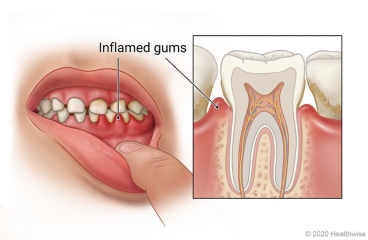Tooth and Gum Pain in Children: Care Instructions
Overview

The most common causes of dental pain are tooth decay and gum disease. Pain can also be caused by an
infection of the tooth (abscess) or the gums. Or your child may have a broken or cracked tooth. Other causes
of pain include infection and damage to a tooth from grinding the teeth. A tooth that is coming in but cannot
break through the gum can cause pain.
Prompt dental care can help find the cause of your child's toothache and keep the tooth from dying or gum
disease from getting worse. Care at home may reduce your child's pain and discomfort.
Follow-up care is a key part of your child's treatment and safety. Be sure to make and go to all
appointments, and call your dentist or doctor if your child is having problems. It's also a good idea to know
your child's test results and keep a list of the medicines your child takes.
How can you care for your child at home?
-
To reduce pain and facial swelling, put ice or a cold pack on the outside of your child's cheek for 10 to
20 minutes at a time. Put a thin cloth between the ice and your child's skin. Do not use heat.
-
If the doctor prescribed antibiotics for your child, give them as directed. Do not stop using them just
because your child feels better. Your child needs to take the full course of antibiotics.
-
Give your child anti-inflammatory medicines such as ibuprofen (Advil, Motrin) to reduce pain and swelling.
Be safe with medicines. Read and follow all instructions on the label.
-
Do not give your child very hot, cold, or sweet foods and drinks if they increase pain.
-
Rinse your child's mouth with warm salt water every 2 hours to help relieve pain and swelling. Older
children (starting around age 8) can do this by themselves. Mix 1 teaspoon of salt in 8 ounces of water.
-
Talk to your dentist about your child using special toothpaste for sensitive teeth. To reduce pain on
contact with heat or cold or when brushing, help your child brush with this toothpaste regularly or rub a
small amount of the paste on the sensitive area with a clean finger 2 or 3 times a day. Floss gently between
your child's teeth.
When should you call for help?
 Call 911
anytime you think your child may need emergency care. For example, call if:
Call 911
anytime you think your child may need emergency care. For example, call if:
Call your dentist or doctor now or seek immediate medical care if:
Watch closely for changes in your child's health, and be sure to contact your doctor if:
Current as of: August 6, 2023
Content Version: 14.0
Care instructions adapted under license by your
healthcare professional. If you have questions about a medical condition or this instruction, always ask
your healthcare professional. Healthwise, Incorporated disclaims any warranty or liability for your use of
this information.